Picc-Line ou Pique Life ?
“Picc-Line or Pique Life?” Indeed, as a patient, I asked myself the question by doing a SWOT analysis: strength, weakness, opportunities, threats.
Sometimes there is only a thread between health and marketing… even a needle!
To begin with, I would like to tell you what a picc-line is and what it is used for.
Doctors do not only use this technique for cancer patients. Indeed, health care personnel also use it for patients who need to be connected simultaneously to several different bags containing all kinds of products.
I want to make it clear that I am not a doctor or even an orderly!
I have been ill with cancer since 2019 and it was while being treated that I became interested in existing and upcoming techniques.
I learned the definition of “Picc-Line” as recently as a month ago, when I agreed, on the advice of my doctor, to have one installed.
I didn’t really have a choice since I was categorized as “severely undernourished”. Personally, I didn’t realize what the problem was, even though my family and friends kept telling me. To tell you the truth, I even thought I had a belly!
When the doctor told me I should have one, I searched the internet for what it was and couldn’t find anything specific about it.
That’s why I decided to write an article about this technique now that I’ve been using it for over a month. I sincerely hope that it will be useful to you.
Here are some explanatory diagrams:
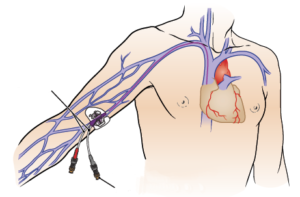
Firstly, The Picc-Line is a 23,62 inches long catheter. It finds its way through a large deep vein (the superior vena cava).
Next, it is usually implanted in the forearm or above the armpit
Finally, the exit point is the same for everyone, however. It is placed at the right atrium of the heart which is “a powerful pump” to distribute the injected product as quickly and efficiently as possible.
So much so that, on the doctor’s advice, I have to walk daily not only to avoid losing muscle mass but also so that the product can be well distributed in the body.
The entry point will be on the left if you are right-handed and vice versa.
This technique is used forlong term treatment ranging from 2 months, to much longer. In this case, it is necessary to replace the Picc-Line which has a limited life span of 6 months.
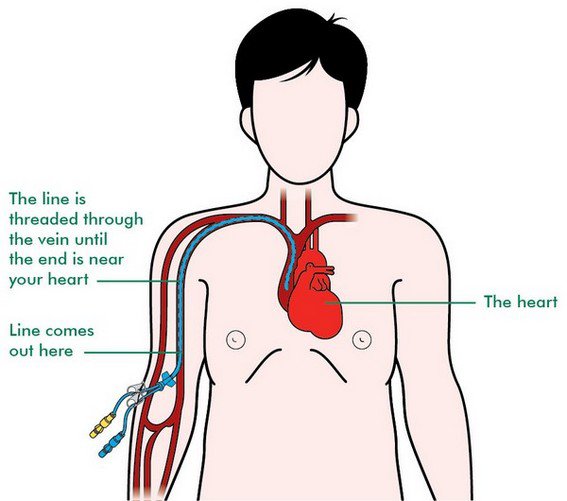
The entry point allows for a sort of “multi-socket” to be inserted.
Thus, caregivers can insert different bags into it simultaneously. And also draw blood.
The main advantage of the Picc-Line is to limit the multitudes of contact points with the syringe on the skin.
So it avoids infections that can become serious like sepsis.
In addition, There is a “small” 7,87 inches picc-line.
It has the same entry point, but it only works for a few days or even weeks. It is called the« midline ».
I invite you to click on this link which will allow you to view both forms of catheterization.
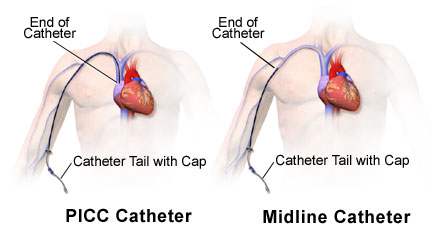
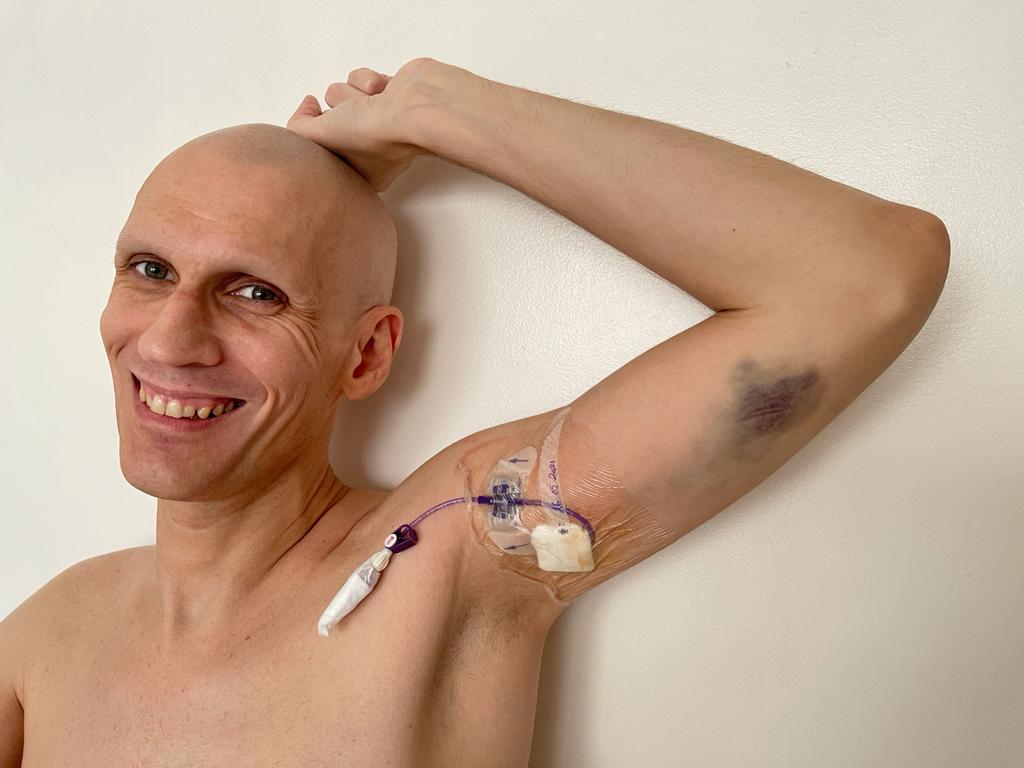
In the case of cancer, why a Picc-Line?
When the doctors accidentally diagnosed my leukemia (T‑type acute lymphoblastic leukemia) in the summer of 2019, they were very encouraging in telling me that it was healing very well and quickly.
However, the 2/3 months that was announced has now become 2 years… And I still have no real visibility.
My little 75,98 inches body is making very resistant metastases that have had a nasty habit of spreading to other organs.
The doctors have classified my cancer as stage IV, generalized. My life prognosis is committed. But who says committed doesn’t mean lost. It’s just going to be a longer, harder fight.
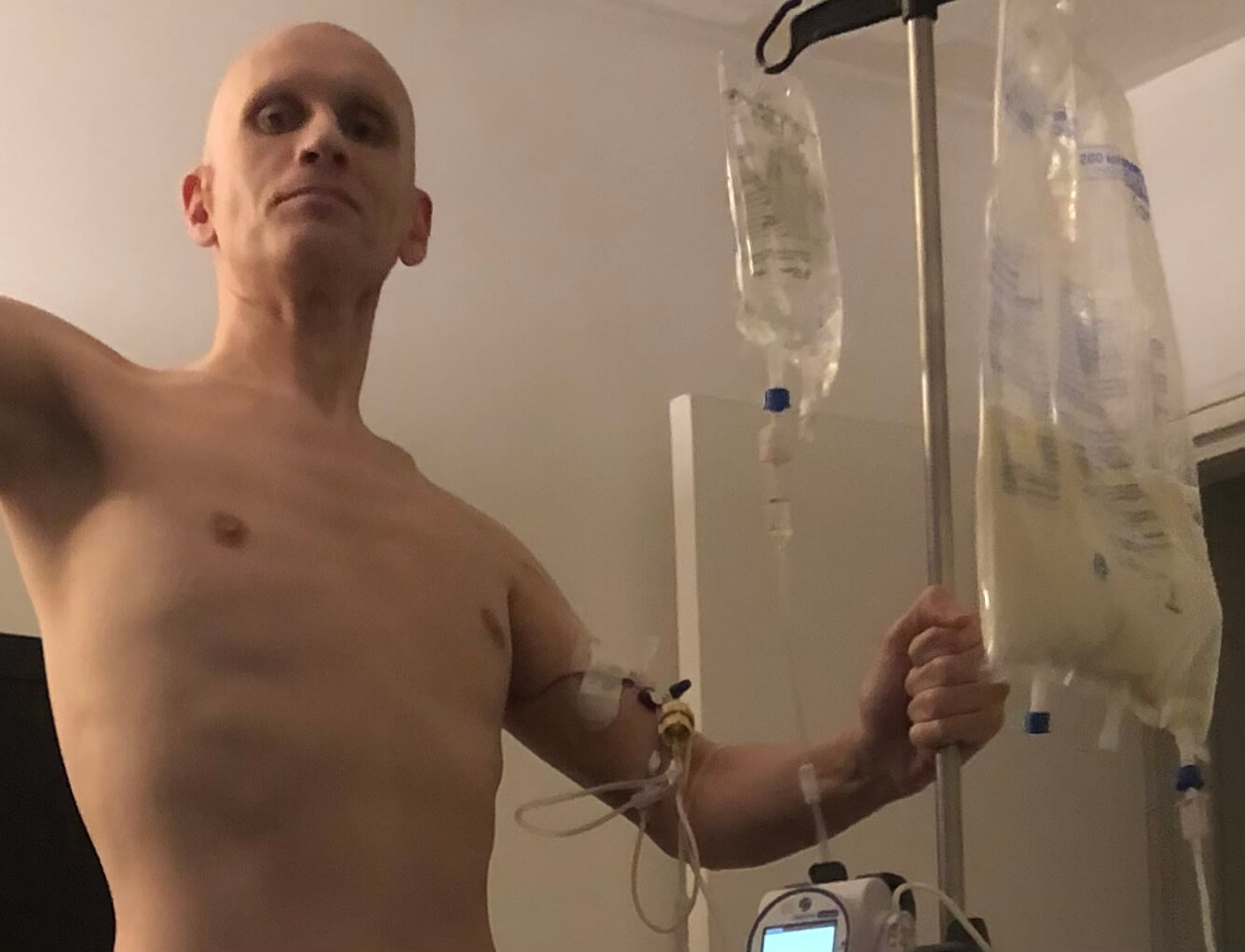
My Picc-Line carries two pockets.
One is nutritious. It has all the elements we need, vitamins, calories depending on body size.
This is called parenteral nutrition.
The other is hydrating.
This system allows me to not lose weight when the nausea from treatments is too strong.
It also has a role of providing nutritional reeducation for patients who are in severe undernutrition.
So I force myself to eat every day to keep my gastric system working and regain weight.
PICC-LINE, THE POSITIVE POINTS:
In my case, I consider this device to be positive, although restrictive; let me explain.
- First, chemotherapy destroys cells, but it does not discriminate between good and bad cells. It greatly reduces our immune defenses and exhausts patients. That’s why many people die, because they become too fragile and catch the first infection they are exposed to.
Patients also die from infections due to the multiple acts of care. Indeed, the slightest prick, small wound, is an “entry point” for germs that penetrate a very weakened body.
- Secondly, as you often see, cancer patients (but not only unfortunately) become very thin. For me, I lost 55,12 lb (I was not overweight) between the time the disease started and the time it was diagnosed.
So before I started chemo, I was already in a weakened state. The treatments made me lose even more my appetite, the desire to drink…
Chemo creates a lot of side effects. In my case, I was very tired, I lost my hair and my eyebrows. I have regular nosebleeds. Like most patients treated with chemotherapy, I have nausea. I have lost a lot of weight and the habit of eating properly.
In this, the Picc-Line brings a vital help.
Depending on the number of calories prescribed by the doctor, it allows me to maintain my weight at a level where there is no more undernutrition.
Above all, it helps me to resume, little by little, without anxiety, the habit of eating normally.
THE PICC-LINE: ADVANTAGES BUT ALSO IMPORTANT CONSTRAINTS:
This procedure is fairly new in that it has only been available for a few years.
The insertion of the “beast” is done by local anesthesia.
An anesthesiologist, ultrasound technician or radiologist inserts the cannula under ultrasound.
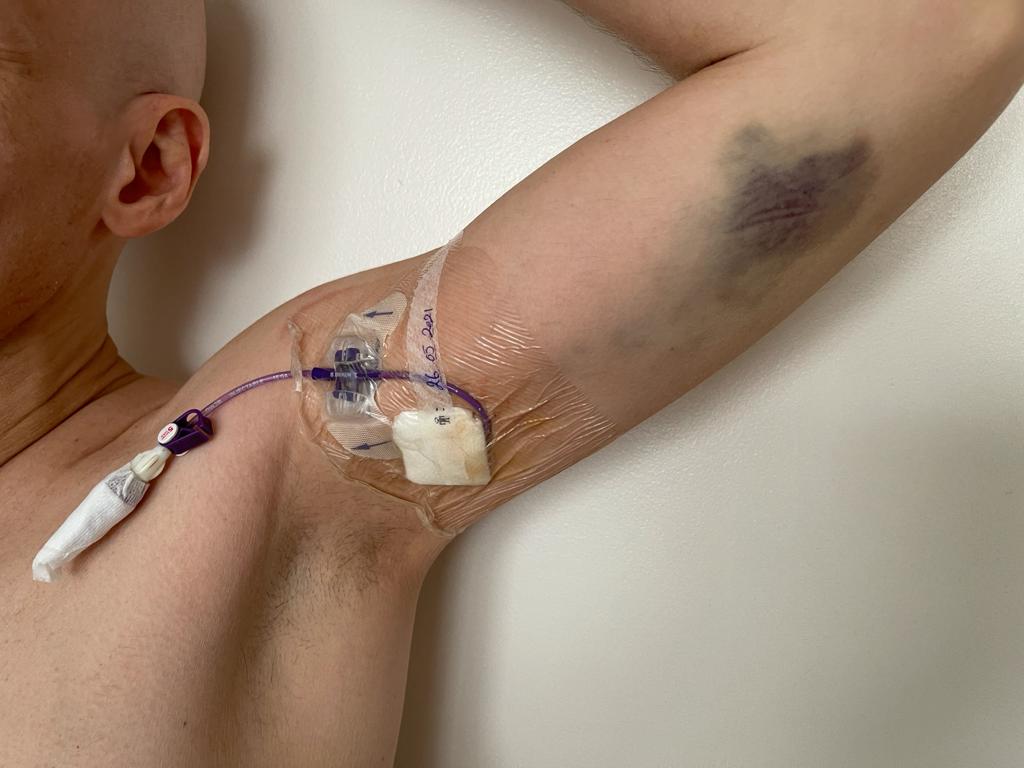
He must be very precise.
It often happens that he has to start the insertion again, if the vein he has to prick slips.
This was in fact my case.
After 1 month of use, I could measure the advantages and disadvantages of the Picc-Line.
I am connected to the machine, for 12 hours, taking into account that I will sleep during this period (8pm to 8am). However, I find it difficult to move around, even though the serum holder has wheels because the wires that connect the bags to my body are very short.
When I am disconnected, only my catheter remains attached to my arm. I am completely free to move.
However, this freedom has its limits.
Indeed, as the incision is made on the surface of my skin, any immersion at the level of the incision is strictly forbidden.
From then on, when I wash, I have to do my cleansing in two steps. I clean my entire upper body with a washcloth (in front of a well-lit mirror so that no drops touch the dressing, which is permeable). Then I wash from torso to toe in the shower. So I can forget this summer about swimming in the pool or the sea.
Once the treatment is over, I will not be released immediately because the risk of relapse is not unlikely. It would be a shame to take me off the Picc-Line and put me on another one a month later.
I will have to keep it on for another 2 months after my treatment ends.
My cardiologist wrote a prescription specifically for this. I’m on it until about August 15 if all goes well.
I will be completely free of my catheter around October 15.
The main drawback of the Picc-Line is practical.
It impacts my daily life greatly limiting my freedom of movement.
I nickname it with this slimy pun: the “Pique Life”.
But I wanted to give it a meaning: I gain freedom because I don’t have to stay in the hospital.
Several nurses take turns every day to put the equipment on me every evening. Every morning to remove it. And once a week to redo the entire dressing, which is a delicate gesture.
Wherever I am, I need to make sure that a registered nurse is available at that location.
That’s not all. I have to find health care personnel who are comfortable with the Picc-Line and that is difficult, I can assure you! I have experienced this and it has caused me many sleepless nights!

Specifically:
So in order to go away for a weekend for 2 days, I need to make sure beforehand that there are nurses who know how to handle a case like mine.
Also, I need to make sure I am not too far from a hospital in case of a sudden infection.
If I was able to “check off” all the boxes, I then have to prepare the material, the right number of pockets etc. and that takes up space in the trunk!
If I go on vacation or business trip for a week or more, I must :
- Find a competent health care professional who is available during the period and willing to travel.
- To be able to have all the necessary products delivered to me (bags, sterile material, tubing) by a nearby pharmacy. A nutrition bag is very heavy and weighs more than 4,4 lb. So, if I leave for 2 weeks, I will need 66,13 lb of nutrition bags and 15,43 lb of hydration bags.
- Take my infusion stand with wheels.
- Find a place that is equipped with electricity (very close to the bed) to connect the computer that calculates the flow of the pockets as well as the duration of it.
- To choose beforehand the top garment that I want to wear or not because once the picc-line is connected under the armpit, it is impossible for me to put on or take off a T‑shirt during the night.
- Even if it is possible to manage an outing to a restaurant, by putting the pockets in a backpack provided for this purpose, the question of clothing remains the same.
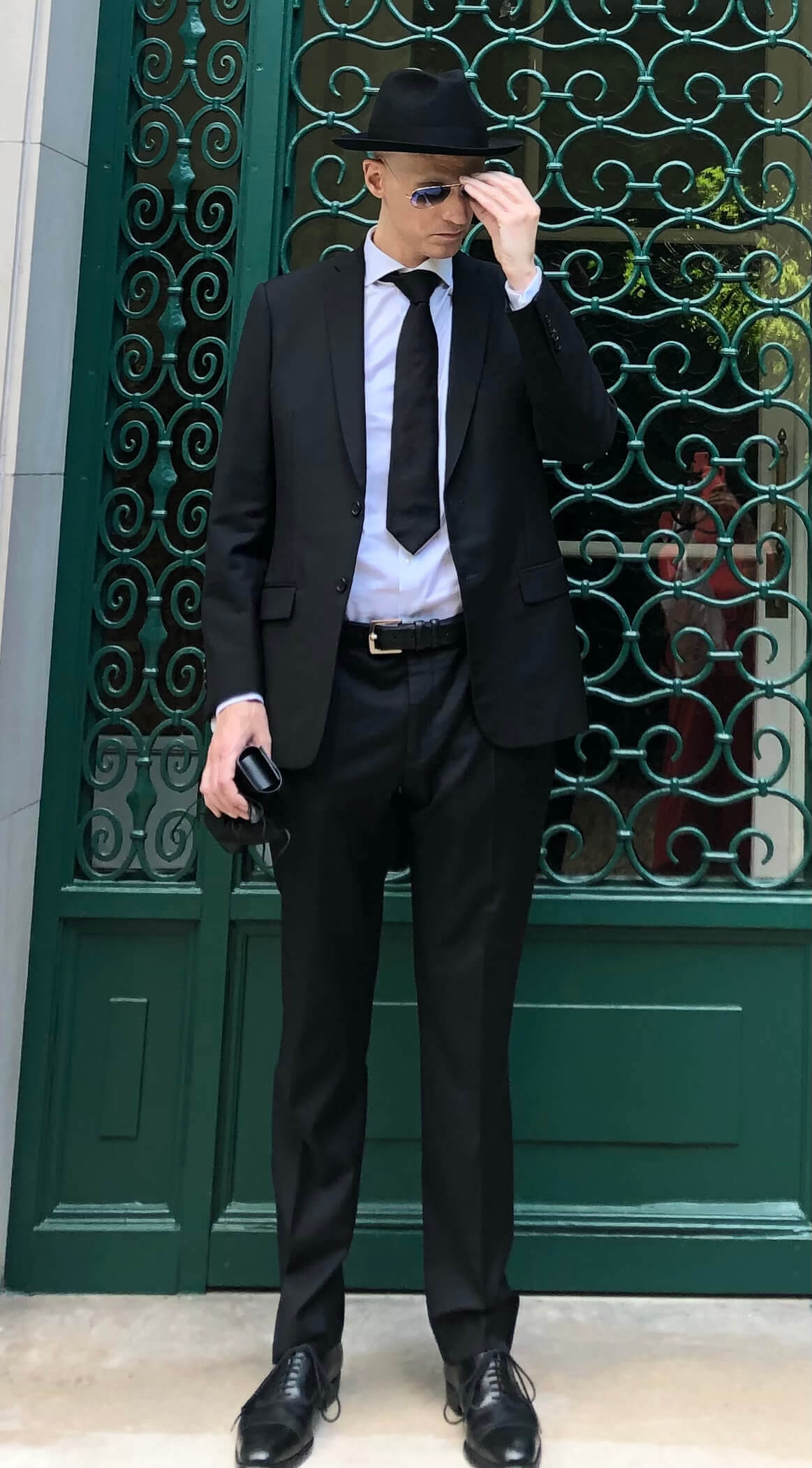
I have undertaken to tell you about both the advantages and disadvantages because it is necessary in the case of such a technique to be fair and objective.
Its main advantage is that you can be treated at home and not in the hospital.
And it’s no small thing to avoid being in the hospital too much in this time of pandemic. And beyond that, hospital-acquired diseases that I am more likely to get. Even 10 years ago, before the invention of the Picc-Line, this could only be done in the hospital.
I am lucky enough to have a “new generation” catheter that allows me to avoid as much as possible the numerous injections that the caregivers would have to give me and the appearance of germs.
All the medical procedures I receive are painless.
As you can see on the documentary produced and posted by LEVA LABORATORIES, the catheter, as bulky as it is, is invisible when I am dressed.
Also, I tried to be as clear as possible about a technique that can be defined as revolutionary with its disadvantages but also with its advantages.
I invite you to watch the documentary “PICC-LINE & PARENTAL NUTRITION” produced and broadcast on the LEVA LABORATORIES website.
Documentary to view at the end of this article.
Here, go directly to the video tab of the LEVA website.
And on the youtube channel of LEVA here.
I don’t compromise on hygienic rigor and constant freedom from pain because cancer already gives enough.
In this sense, the Picc-Line fulfills the main qualities that I am looking for even if I do not remain stunned in front of it, the drawbacks not being negligible.
In fact, I would say that it is according to what each person is looking for that you will have to make a choice. Preferably talk to your surgeon. But in the end, only he will make the decision to choose the best solution according to your state of health and what you can bear.
These notable inconveniences change my life but especially that of my loved ones.
Obviously, spontaneity is much more difficult to implement, as you will have understood. You can no longer decide to stroll around in the evening because the health professional has to come by at a certain time to hook you up. It is impossible to leave at the end of the day on a whim to go on an outing or an impromptu weekend.
The people who love me and with whom I live, see their daily life upset. But moreover they also accept to see their comfort zone restricted. Effectively, less outings, no more sleeping in, no more space for boxes at home, no more logistics for medical deliveries. All this is added to the multiple tasks already performed by the caregiver. As well as the multiple appointments with doctors, and the exams to be done…
I don’t forget that I am very privileged compared to the other millions of cancer patients in the world.
I live in a country with one of the best health care systems in the world and I have no shortage of professionals around me to help me heal.
In my case, it is not planned that I keep it all my life but only a few months.
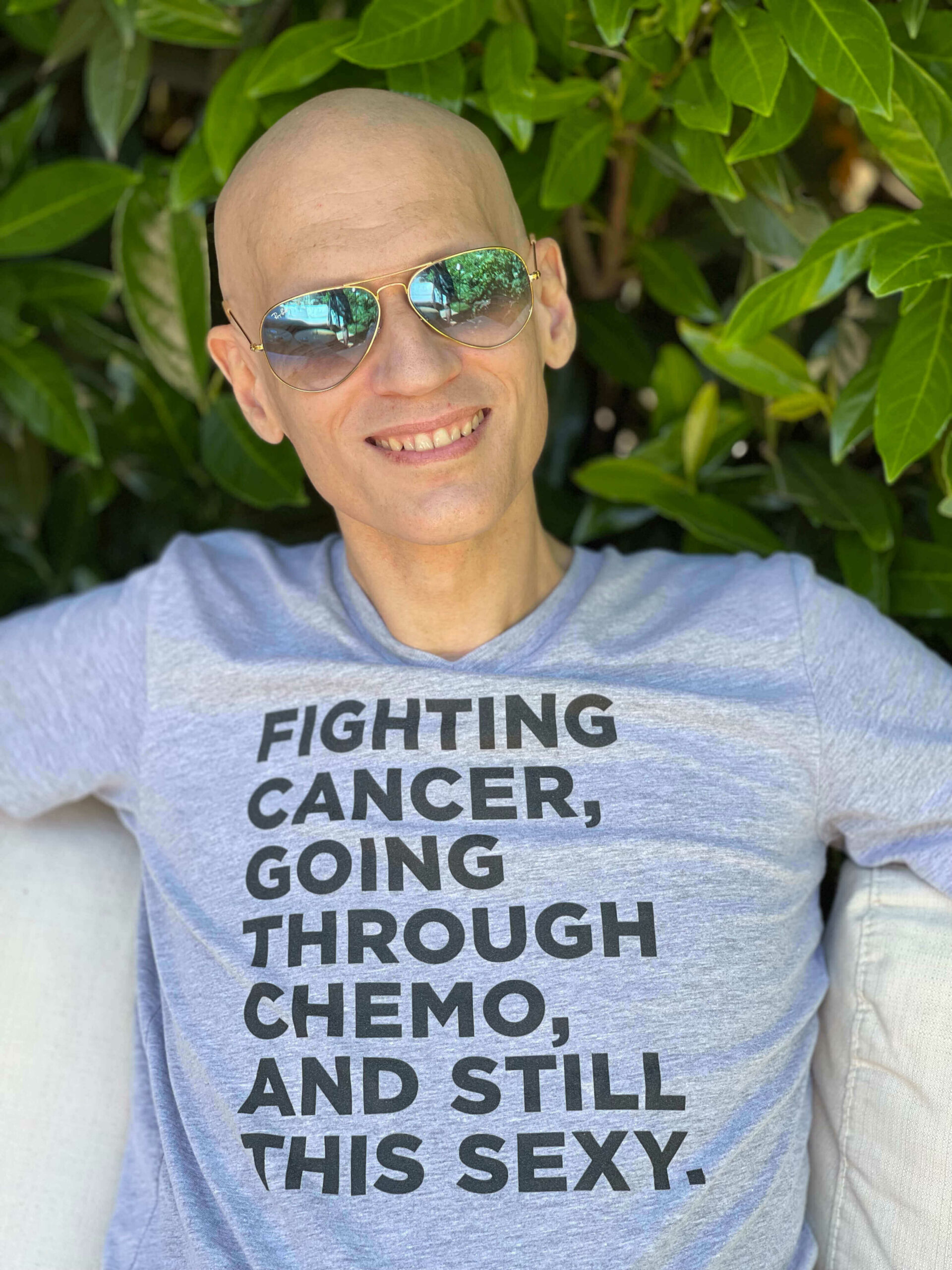
This is part of the foundational experience that I have been living for the past 2 years because I will not be the same man I was before I got sick.
I am certain of one thing: I will fight until my last breath to love, to live and enjoy life.
The Picc-Line being an additional ally in this battle to the death with the disease.
William Shakespeare wrote: “My body is a garden, my will is its gardener”.
This has never been more true.
Text by Yaakov-Lev Schneersohn-Salzman.
Photos by Sarah-Lev Schneersohn-Salzman

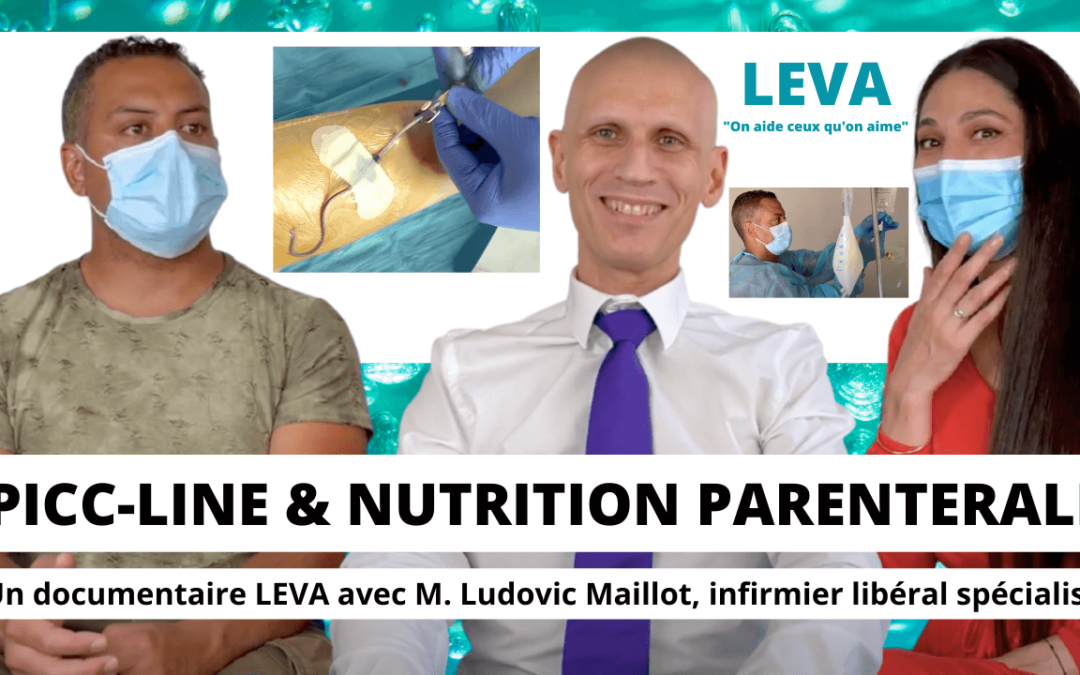
Recent Comments